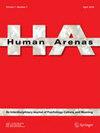A New Housing Mode in a Regional Landscape of Care: A Sociocultural Psychological Study of a Boundary Object
IF 0.9
Q3 PSYCHOLOGY, MULTIDISCIPLINARY
引用次数: 0
Abstract
Abstract The study of ageing, which received growing attention over the past 30 years, has progressively realised the importance of the cultural, historical, and socio-economical environment for the various courses of ageing. However, we believe that it could be further conceptualised. First, we propose to enrich it through the notion of “landscape of care” developed by geography. Second, the distinction developed by sociocultural psychologists between sociogenesis, microgenesis, and ontogenesis is useful to articulate different scales of the landscape of care and to consider individual trajectories. Finally, the notion of boundary object leads us to discuss how a specific object might play a bridging function in this landscape. We draw on a regional case study carried out in a Swiss canton where the building of “flats with referees” is part of a new policy that aims at adapting the care and support network to demographic change and to favour ageing in place. Our hypothesis is that these flats may have a function of boundary object as they lead various actors to collaborate. Based on observations, desk research, and interviews, the study shows that on a sociogenetic level, these flats have a bridging function. However, on ontogenetic and microgenetic levels, divergences and misunderstandings hinder these flats to fully achieve this function. By examining the changes in the landscape of care, this article contributes to a better understanding of people’s trajectories within their sociocultural environments.区域关怀景观中的新居住模式:一个边界对象的社会文化心理学研究
老龄化研究在过去的30年里受到越来越多的关注,人们逐渐认识到文化、历史和社会经济环境对各种老龄化过程的重要性。然而,我们相信它可以进一步概念化。首先,我们提出通过地理学发展的“关怀景观”概念来丰富它。其次,社会文化心理学家对社会发生、微发生和个体发生的区分有助于阐明不同尺度的关怀景观,并考虑个体轨迹。最后,边界物体的概念引导我们讨论一个特定的物体如何在这个景观中发挥桥梁作用。我们借鉴了在瑞士一个州进行的区域案例研究,在那里,“有裁判员的公寓”的建设是一项新政策的一部分,该政策旨在使护理和支持网络适应人口变化,并有利于老龄化。我们的假设是,这些平面可能具有边界对象的功能,因为它们引导不同的参与者合作。基于观察、案头研究和访谈,该研究表明,在社会遗传学层面上,这些公寓具有桥梁功能。然而,在个体发生和微发生水平上,分歧和误解阻碍了这些单位充分实现这一功能。通过研究护理环境的变化,本文有助于更好地理解人们在其社会文化环境中的发展轨迹。
本文章由计算机程序翻译,如有差异,请以英文原文为准。
求助全文
约1分钟内获得全文
求助全文
来源期刊

Human Arenas
Social Sciences-Social Sciences (miscellaneous)
CiteScore
2.80
自引率
23.10%
发文量
55
期刊介绍:
The aim of this journal concerns the interdisciplinary study of higher psychological functions (as topic of a general theory of psyche from the perspective of cultural psychology) in human goal-oriented liminal phenomena in ordinary and extraordinary life conditions. The journal is organized around topics and arenas of human activity, rather than the traditional boundaries of academic disciplines. It will explore human arenas from the point of view of historical foundations, methodology, epistemology, and the intersection of disciplines. Human Arenas promotes an innovative mix of theoretical and empirical studies, as well as qualitative and quantitative approaches based on “small data,” that is, the analysis of crucial and meaningful data, rather than the inductive accumulation of large empirical “evidence.”
 求助内容:
求助内容: 应助结果提醒方式:
应助结果提醒方式:


